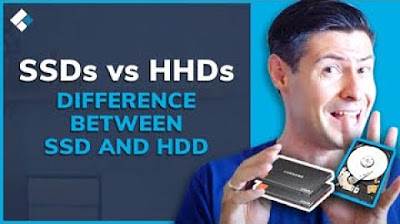Mr Long Computer Terms | What's the difference between HDD and SSD?
Summary
TLDRThis video explores the key differences between Hard Disk Drives (HDDs) and Solid State Drives (SSDs). It highlights how HDDs use spinning disks and mechanical arms for data storage, making them slower and less durable, but cheaper for larger capacities. In contrast, SSDs employ flash memory, offering faster access speeds, greater durability, and lower power consumption, though at a higher cost per gigabyte. The video also discusses the relevance of defragmentation, noting that while HDDs benefit from it, SSDs do not. Ultimately, the choice between the two depends on the user's specific storage needs and performance requirements.
Takeaways
- 😀 HDD stands for Hard Disk Drive, while SSD stands for Solid State Drive, both serving as storage devices for data.
- 🚀 SSDs offer faster read/write speeds compared to HDDs, resulting in quicker boot times and faster application loading.
- 📦 HDDs are larger and heavier due to moving parts, whereas SSDs are compact and lightweight, containing no moving components.
- 🔒 SSDs are more durable and reliable than HDDs, as they are less vulnerable to physical damage and mechanical failure.
- 🔋 SSDs consume less power than HDDs, contributing to longer battery life in laptops and other mobile devices.
- 💰 HDDs are generally less expensive per gigabyte compared to SSDs, making them a cost-effective option for large storage.
- 📏 Defragmentation is important for HDDs to maintain performance, while it is not recommended for SSDs due to potential wear and tear.
- 🛠️ SSDs use a technique called TRIM to optimize performance, informing the operating system about unused data blocks.
- 🖥️ Both HDDs and SSDs are compatible with most modern computer systems, including laptops and desktops.
- 🌟 As technology advances, SSDs are becoming more popular due to their speed and efficiency, especially for tasks requiring fast data access.
Q & A
What does HDD stand for, and how does it store data?
-HDD stands for Hard Disk Drive. It stores data by magnetizing tiny areas on spinning discs using a read/write head that moves mechanically.
What does SSD stand for, and how is it different from HDD?
-SSD stands for Solid State Drive. Unlike HDDs, SSDs store data on electronic circuits using flash memory chips, which allows for faster data access.
What are the key differences between HDDs and SSDs?
-The key differences include storage method, speed, size, durability, cost, and the need for defragmentation.
Why are SSDs faster than HDDs?
-SSDs are faster because they use electronic circuits without moving parts, allowing for quicker data retrieval compared to the mechanical components of HDDs.
What are the implications of the physical size of HDDs and SSDs?
-HDDs are larger and heavier due to their moving parts, while SSDs are smaller and lighter because they contain no moving components.
How does durability differ between HDDs and SSDs?
-SSDs are more durable and reliable since they lack moving parts, making them less vulnerable to physical damage compared to HDDs, which can fail due to mechanical issues.
Which storage type generally has a lower cost per gigabyte?
-HDDs typically have a lower cost per gigabyte compared to SSDs, making them more cost-effective for large storage needs.
What is defragmentation, and is it necessary for SSDs?
-Defragmentation is the process of reorganizing scattered files on a hard drive for better access speed. It is necessary for HDDs but not recommended for SSDs, as it can cause unnecessary wear on flash memory cells.
What optimization technique do SSDs use instead of defragmentation?
-SSDs use a technique called TRIM, which allows the operating system to inform the SSD of unused data blocks, enabling the SSD to erase and consolidate these blocks proactively.
When is it more advantageous to use an HDD over an SSD?
-HDDs are more advantageous for storing large amounts of data at a lower cost when speed is not crucial, such as for media libraries or backups.
Outlines

Dieser Bereich ist nur für Premium-Benutzer verfügbar. Bitte führen Sie ein Upgrade durch, um auf diesen Abschnitt zuzugreifen.
Upgrade durchführenMindmap

Dieser Bereich ist nur für Premium-Benutzer verfügbar. Bitte führen Sie ein Upgrade durch, um auf diesen Abschnitt zuzugreifen.
Upgrade durchführenKeywords

Dieser Bereich ist nur für Premium-Benutzer verfügbar. Bitte führen Sie ein Upgrade durch, um auf diesen Abschnitt zuzugreifen.
Upgrade durchführenHighlights

Dieser Bereich ist nur für Premium-Benutzer verfügbar. Bitte führen Sie ein Upgrade durch, um auf diesen Abschnitt zuzugreifen.
Upgrade durchführenTranscripts

Dieser Bereich ist nur für Premium-Benutzer verfügbar. Bitte führen Sie ein Upgrade durch, um auf diesen Abschnitt zuzugreifen.
Upgrade durchführenWeitere ähnliche Videos ansehen

(SSDs vs HHDs) What's The Difference Between SSD and HDD?

BTEC Level 3 IT - P04 - Storage Devices - HDD, SSD, SD, Magnetic Tape, USB Memory Stick, Optical

10+ Key Memory & Storage Systems: Crash Course System Design #5

Computer Components For Dummies

Fragmentation and Defragmentation | Windows 10

M.2 vs SSD vs HDD – Best Storage for Gaming
5.0 / 5 (0 votes)
